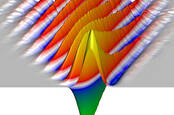This article is more than 1 year old
If you're looking for a textbook example of an IT hype cycle, let spin be your guide
Spintronics is/was cool
Column The four horsemen of disaster in IT decision-making are fear, uncertainty, doubt – and hype. FUD famously first pranced forth when IBM ran the world and its salespeople ladled them out over any upstart which had a chance of taking market share. But hype – ah, hype. The salesman-on-uppers to FUD's downer street preacher, it wants your investment of hope so it can bolster those of others. It's a pyramid scheme of promises.
FUD concentrates on things that exist, or are at least real enough to be threatening. You have a chance of kicking the tyres. With hype, though, it's future-looking. Our best bet is to look at previous examples and find common patterns, something that expert hype-meisters in the large analyst and consultancy groups know instinctively to avoid. Fortunately, we have tools. So, let's pick one particularly clean example of recent years and see where it leads.
My personal favourite part of IT is fundamental technology. The stuff at the bottom. In the past decade or three, I've particularly enjoyed memristors, ultra-wideband radio, and spintronics. Spintronics is especially good because it uses the star player in tech hype, basic quantum physics, and it is by now a dim but not quite extinguished memory. Let's check that it was indeed hype by searching in Google Ngrams to find out how often the word appeared in books between 1990 and 2018 – play along at home.
What a beautiful signal. A lovely early exponential burst starting in the late 1990s, building to a strong peak over seven years to 2004, thence decaying back into the noise in 2012, never to be seen again. This is textbook hype.
Spintronics is an intriguing idea, which is what gave it the fuel to rise in the first place. It came out of some fundamental research in manipulating the spin of electrons. Ordinary digital electronics pushes electrons through logic gates, where the cumulative charge – or not – makes the ones and zeros from which all good things flow. As well as charge, electrons have spin and if you can detect what that spin is and also change that spin on command, you can make electrons carry a useful signal for logic without having to actually move them.
This is jolly exciting. If you don't move electrons, you don't use nearly as much energy or generate nearly as much heat – the two things that limit just about everything digital right now. So when something called giant magnetoresistance (GMR) was found in the late 1980s, it was big news: spin causes magnetism, and this discovery used that to make small amounts of spin detectable. So quickly did the discoveries come that the first hard disks using GMR were on the market by 1997.
All this coincided with some of the first glimpses of Moore's Law running out of steam – albeit decades distant – and the semiconductor industry got very keen on the idea that they had plenty of time to ramp up on spintronics to pick up the cadence of development and progress serenely yet profitably into the future. The air filled with the sound of leathery-winged PRs issuing press releases and IT hacks – yours truly included – trying to keep up.
The 2000s were exciting. New materials, single-electron devices, even practical memory chips were produced. Hundreds of millions of dollars were spent in basic research, and you can follow the timeline here. Yet we're not running spintronic iPhones – and the chip-flippers are still eking the last drops out of good old-fashioned CMOS.
The problem, as always, is you know who lives in the details. "Spintronics could make computers the size of a pea that run the world" is great, but "Our six-year, ten-million-dollar, EU-funded project we started in 2014 has shown us by 2020 that antiferromagnetic materials are interesting and not useless" gets less attention. (Until now. Thanks, guys.) And that's typical for new physics: the sudden, single early significant application didn't change the fact that ordinary semiconductors are the end result of 50 years' hard work in practical discovery and engineering, and this never gets mentioned in the early hype for anything that is being touted as a replacement. History is our guide, if we bother to do the research: hype depends on laziness.
There's still spintronics hype out there. Go back into the Googles and search for it in the news category. You'll find confident predictions of the huge size of the spintronics market that is to come, and you'll find them in a wide selection of strange news outlets you won't have heard of before. I'll leave it as an exercise to the reader to work out what's happening there.
And there is still spintronics research going on, of course. There are new materials, new theories, new devices, but below the radar, the way that most science and fundamental technology normally happens. It's interesting, important stuff, and from it some exciting things will come. But I can't say when and I can't say what. But I can say that hype is no guide, and that you too can – and should – learn the real physics of spin. ®

